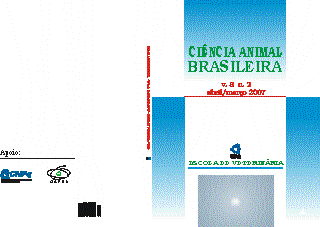PREGNANCY RATES IN HEIFERS INSEMINATED WITH SEMEN OF NELORE BULLS SEXED BY FLOW CYTOMETRY
DOI:
https://doi.org/10.5216/cab.v8i3.1734Keywords:
Pregnancy, Insemination, ReproductionAbstract
The flow-sorting sperm technology is considered as the most promising technique for sexing semen, due to the separation accuracy of around 90%. Thus, the objec-tive of this study was to determinate the effect of Articial Insemination (AI) with semen of Nelore bulls sexed by flow cytometry on the pregnancy rate and its accuracy. Throughout the study, 427 Nelore heifers were inseminated with only one dose of semen as follows: 241 heifers were treated with flow-sexed sperm (3 x 106 total flow-sorting X-chromosome bearing sperm/dose) and 181 were treated with unsexed sperm (10 x 106 total sperm/dose). The heifers were inseminated after detection of natural heat or after syn-chronization treatment. The results obtained for pregnancy rates did not indicate differences between flow-sexed and unsexed sperm and the accuracy in the sex determination presented high levels and reliability (92.4%).
KEY-WORDS: Bovine, Nelore, spermatozoa, sexing.
Downloads
Downloads
Published
How to Cite
Issue
Section
License
Authors who publish with this journal agree to the following terms:
- Authors retain copyright and grant the journal right of first publication with the work simultaneously licensed under a Creative Commons Attribution License that allows others to share the work with an acknowledgement of the work's authorship and initial publication in this journal.
- Authors are able to enter into separate, additional contractual arrangements for the non-exclusive distribution of the journal's published version of the work (e.g., post it to an institutional repository or publish it in a book), with an acknowledgement of its initial publication in this journal.
- Authors are permitted and encouraged to post their work online (e.g. in institutional repositories or on their website) prior to and during the submission process, as it can lead to productive exchanges, as well as earlier and greater citation of published work (See The Effect of Open Access).




























